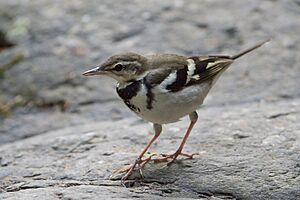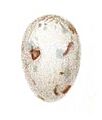Forest wagtail facts for kids
Quick facts for kids Forest wagtail |
|
|---|---|
 |
|
| Conservation status | |
| Scientific classification | |
| Genus: |
Dendronanthus
|
| Species: |
indicus
|
| Synonyms | |
|
Limonidromus indicus |
|
The forest wagtail (Dendronanthus indicus) is a cool, medium-sized bird that belongs to the wagtail family. It looks different from other wagtails because of its special feather patterns. What makes it really unique is how it wags its tail: it moves side-to-side, not up and down like other wagtails! It's also the only wagtail that builds its nest in trees. You can find these birds mostly in forests. They breed in cooler parts of east Asia and spend their winters in warmer, tropical areas from India to Indonesia.
Contents
About the Forest Wagtail's Name
The forest wagtail was first officially described in 1789 by a German scientist named Johann Friedrich Gmelin. He gave it the scientific name Motacilla indica. The word indica comes from Latin and means "Indian." This name was based on notes from a French scientist, Pierre Sonnerat, who described the bird in 1782.
Later, in 1844, an English zoologist named Edward Blyth created a new group, or genus, just for this bird. He called it Dendronanthus. This name comes from two old Greek words: dendron meaning "tree" and anthus, which is part of the name for another group of birds called pipits. So, Dendronanthus basically means "tree pipit-like bird," which makes sense since it lives in trees! This bird is the only species in its group, meaning there are no different types or subspecies of forest wagtails.
What Does the Forest Wagtail Look Like?
This wagtail is very easy to spot because it's the only one in its special group, Dendronanthus. It's about 18 centimeters (about 7 inches) long and has a slim body with a long tail.
Its back and the top of its head are a brownish-olive color. Its wings are black with two bright yellow stripes and white edges on some of the feathers. It has a white stripe above its eye, with a dark stripe going right through the eye. The bird's belly is white, but it has two black bands across its chest. The top band looks like a bib, while the bottom one is often broken. Both male and female forest wagtails look very similar. Young birds, however, have a bit more yellow on their undersides.
The forest wagtail makes a simple "pink pink" sound. You can often hear this call when the bird is on the ground or even flying high in the sky. They also have a soft, gentle song. Sometimes, another bird called the brown shrike will even copy the forest wagtail's calls!
Where Do Forest Wagtails Live?
As its name suggests, the forest wagtail loves forests! This is different from most other wagtails, which prefer open areas. You'll usually find them in open spots within woodlands, like clearings. In winter, they often stay in shady forest areas or along paths in places like coffee farms.
These birds breed in eastern Asia, including parts of Korea, China, and Siberia. They fly to warmer parts of Asia for the winter. It's thought they reach southern India and Sri Lanka by flying over the Andaman Islands. Sometimes, they even show up in unexpected places like the Maldives and Australia, but these are rare visits.
People used to think they only spent winter in southwestern India. But now we know they winter in all the southern parts of India, not just the southwest.
How Do Forest Wagtails Behave?
Forest wagtails are usually found alone or in small groups. They often look for insects in trees, catching them along the branches. They can also search for food on the ground, much like a pipit. If something bothers them, they fly up into the trees with a sharp "pink" sound. They are good at climbing steep branches and can run quickly along horizontal ones. At night, they often sleep together with other wagtails among tall reeds.
Life Cycle and Reproduction
The breeding season for forest wagtails is usually in May in northeastern India and June in the Amur region. These birds leave their winter homes around late March from Sri Lanka and mid-March from the Malay Peninsula. The last ones leave by May. If spring is very cold, they might arrive at their summer breeding spots as late as the end of May.
Male birds sing from May to July. When they sing, they sway their bodies with each part of the song. The forest wagtail is the only wagtail that builds its nest in trees, often choosing oak trees. The nest is shaped like a cup and is made from fine grass and roots, held together with moss and spiderwebs. Only the female builds the nest, while the male watches nearby.
They usually lay five eggs. The female sits on the eggs for about 13 to 15 days. She starts incubating the eggs before all of them are laid, so the chicks hatch at different times. The young birds grow feathers and leave the nest after about 10 to 12 days. Both the mother and father bird help feed the young. Like other wagtails, these birds eat insects.
Besides their unique look and where they live, forest wagtails are special because of their strange tail-swaying habit. They move their tail from side to side, not up and down like other wagtails. The Japanese name for this bird, Jokofury-sekirei, means "sideways-swinging wagtail" because of this habit. In Sri Lanka, they sometimes look for maggots in cattle dung. Because of this, they are known as gomarita, which means "dung-spreader."
Gallery
-
Painting from John Gould's Birds of Asia






